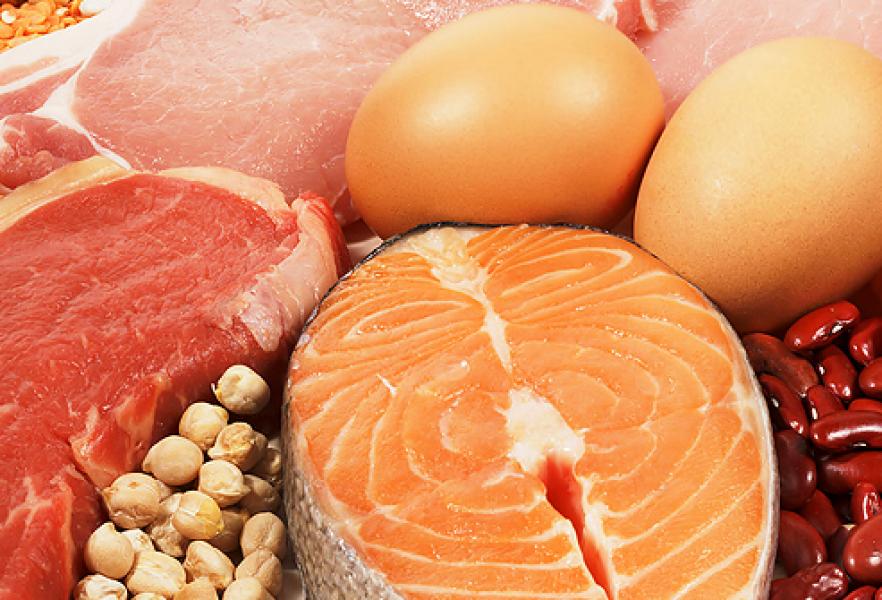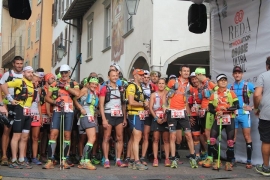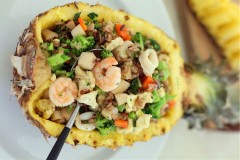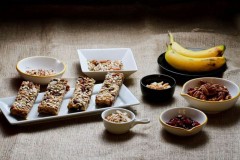关于“The Athlete’s Guide to Recovery: Rest, Relax, and Restore for Peak Performance”这本书谈论的内容,主要是“跑步”及“自行车”运动为主啰。
运动后的营养补充,不能只将焦点放在运动后的当下,而是全天候的饮食才对,所以我们先来看看每日饮食中应该注意到的重点,在书上的第80页写到“Daily Eating”:
Your best approach to recovery nutrition is , quite simply, to eat well all the time. A healthy diet, in Michael Pollan’s now-famous manifesto from In Defense of Food, is comprised of “food. Not too much. Mostly plants." A wide variety of brightly colored foods, mostly vegetables and fruits that, whenever possible, are organic and locally sourced, will provide you with most of what you need.
Prepackaged and processed foods – the bars, gels, and powdered drinks that tend to line the shelves of any athlete’s pantry – have their place, but it is a limited place and pertains to the time immediately preceding, during, and sometimes after exercise. Even then, real food is often the better option, depending on the individual’s constitution and the intensity and duration of exercise.
For a useful book on healthy daily eating habits of athletes, see Adam Kelinson’s The Athlete’s Place : Real Food for High Performance(2009).
简译:每日的饮食中以植物为主,选择各式各样颜色、当地生产的蔬菜水果,并尽可能选择有机栽培的品种。而预先包装处理好的食物,较适合于运动前、运动中及运动结束后来摄取。真食物还是较好的营养选择。
书中谈到的,还是以建议选择“真食物(Real Food)”。在“10种对皮肤有害的食物”有谈到“应该避免处理及包装过的食物。换句话说,食物在经过处理之后,天然酵素(Enzymes)及营养会被破坏并且流失掉,高度食用这类的食品,在营养不足的情况下,这个状况会表露于你的皮肤上。”
因此,在日常的饮食中还是以未经过处理过的食物为主,天然酵素及营养成份都较高;而运动前/中/后,为了增加营养的吸收速度,所以选择易吸收.高浓缩的能量或是营养包做为补充。
而营养的摄取要均衡,书上也做了说明:
Your diet should include a good balance of macronutrients (carbohydrates, protein, and fats). The precise proportion of each that works best depends on your constitution, sport, and activity level and must be determined individually. While we often get into a habit of eating the same thing day in and day out, and while it can be easy to have weekly schedule, variety ensures we get the most from our food.
Eating a well-rounded, natural diet will provide your body with the elements it needs to recover: carbohydrates to supply and replenish energy in the form of glycogen, protein to deliver amino acids to rebuild muscle fiber, and fats to insulate the body and carry vitamins to the cells.
简译:在饮料中应该均衡摄取多量元素(碳水化合物、蛋白质及脂肪),而比例的分配则是要视你运动的内容、强度及个人状况而定。通常我们的饮食习惯都是固定,所以可能每天吃的东西都是一样的。可以先安排每周的菜单,确保可以从食物中均衡摄取到所需的营养。
而运动后营养补充的时间点:
Here’s a timeline for your post-workout nutrition after a long (over 90-minute) or very hard workout.
Within about 30 minutes: Consume a recovery snack to give you the carbohydrates and sodium you need; drink to your thirst. Within about two hours: Enjoy a balanced meal; drink to your thirst. For the rest of the day: Continue drinking to your thirst and eating a variety of healthy foods.
简译:在从事完90分钟以上或是非常艰困的训练后,在30分钟内补充恢复能量的点心,提供身体所需要的碳水化合物及钠,并且适时补充水份。大约2小时内,可以享受你的餐点,也别忘记补充水份。
什么是“Recovery Snack(山姆伯伯暂译:恢复能量包)”:
Your recovery snack should be a mixture of fluids, sodium, carbohydrates, possibly some protein, and not too much fat. Fat can interface with your body’s ability to process the carbohydrates – and the protein – in your recovery snack.
简译:恢复能量包包含了水份、钠、碳水化合物、可能有些蛋白质及少量的脂肪。脂肪会干扰身体处理能量包中的碳水化合物及蛋白质。
为什么要恢复能量包这种东西呢?补充恢复能量包的主要的目的是“恢复的更快”,当你早上训练完之后,下午又要进行训练;或者是今天进行了长跑或是辛苦的训练,肝醣(Glycogen)消耗殆尽,为了让身体加速恢复而补战下一个训练,这时候能量包就会派上用场,除了运动后补充,在每个正餐间的空档也进行补充。
而不晓得大家有没有听过“肝醣之窗(Glycogen Window)”,也就是运动结束后的30分钟内,补充肝醣可以获得到最大的效果,书中第82页有说到:
The carbohydrates you consume in the first 30 minutes after exercise will lead to higher glycogen levels than if you wait for two hours after the workout to begin eating again (Ivy et al. 1998). For this reason, we often hear about a “glycogen window," in which we have to take in our recovery snack for maximum benefits. And while that ‘s true, it’s not as hard and fast as some would make it seem.
The window doesn’t slam shut at 30 minutes postexercise. You have two hours after your workout when you can take in that recovery snack. But you’ ll still be replenishing glycogen depleted during a morning workout when you eat your lunch, your afternoon snack, and your dinner.
In fact, if you’re more depleted, you ‘ll still be replenishing your glycogen stores the next day. Don’t get too hung up on the 30-minute rule, but do remember to pay attention to your recovery snack after longer or intense workout when you need to recover quickly.
简译:在1998年Ivy的研究结果,补充碳水化合物的时段,在运动后结束的30分钟内比起2小时后才进食,肌肉肝醣合成(Glycogen Synthesis)会更为迅速。基于这个原因,我们经常会听到肝醣之窗(Glycogen Window),我们在30分钟的时间内补充恢复能量包可以得到最大的效益。这确实是真得,但30分时间到时,这扇窗并不会立即关上,这扇窗开启有2小时的时间,这段时间你一样可以摄取恢复能量包。
肝醣之窗关闭了,并不表示肝醣的补充工作就结束了。在进行正餐时,身体仍然在补充肝醣。若你训练的时间长或强度很高,肝醣消耗相当严重时,身体进行肝醣补充的工作可能需要更长,适时的补充所需的营养,可以加快身体恢复的速度。
山姆伯伯有查到一篇Journal of Sports Medicine的也有谈到上面的议题,直接将结论抓出来:
The restoration of muscle glycogen after depletion by exercise is a central component of the recovery process. To maximize the rate of muscle glycogen storage during short-term recovery, it is important to consume a carbohydrate supplement as soon after exercise as possible. If consuming only carbohydrate, supplementation should occur frequently, such as every 30 minutes, and provide about 1.2 to 1.5 g of carbohydrate / kg body weight / hr.
简译:在运动后,肌肉肝醣的补充是恢复程序很重要的要素。为了让肌肉肝醣合成的速率达到最大值,在运动结束后愈早补充碳水化合物愈好。若只补充碳水化合物的话,应该经常的进行补充,像是每30分钟,并且以每小时每公斤体重补充1.2至1.5公克的碳水化合物。
However, the efficiency of muscle glycogen storage can be increased significantly with the addition of protein to a carbohydrate supplement. This will reduce both the amount of carbohydrate and frequency of supplementation required to maximize glycogen storage.
简译:若在碳水化合物的补充时加上蛋白质,肌肉肝醣合成的效率会有明显的提升,并且减少碳水化合物补充的量及频率。
If both carbohydrate and protein are consumed, it is recommended that 0.8 g carbohydrate·kg body wt plus 0.2 g protein·kg -1 body wt be consumed immediately and 2-hours after exercise during a 4-hour recovery period. The addition of protein to a carbohydrate supplement also has the added advantage of limiting post exercise muscle damage and promoting muscle protein accretion.
简译:若同时补充碳水化合物及蛋白质时,建议每公斤体重补充[0.8公克的碳水化合物 + 0.2公克的蛋白质]。在运动结束后马上补充1次,经过2小时之后,每4小时补次一次,而加上蛋白质的优点也能限制肌肉的损坏并且帮助肌肉蛋白的合成。
Along with a rapid increase in muscle glycogen, these processes can have a significant impact on subsequent exercise performance.
简译:随着肌肉肝醣迅速的增加,这些过程将会在之后运动的表现上造成明显的效果。
而Recovery Snack(恢复能量包)到底有什么可以选呢?书上第86页有列出一些组合,其中一个大家已经知道的“巧克力牛奶”:
■ Chocolate milk (巧克力牛奶)
■ Chocolate soymile (巧克力豆浆)
■ Bagel with jam, cream cheese, peanut butter, or a slice of turkey (贝果加果酱、奶油乳酪、花生酱或一片火鸡肉)
■ Smoothie (fruit and/or vegetables belended with cow’s milk; soy, almond, or rice milk; or yogurt)
■ Fruit and yogurt (新鲜水果与优格)
■ Cereal with cow’s milk or soy, almond, or rick milk
■ Fresh juice and a handful of nuts (新鲜果汁及一把坚果)
上面介绍完之后,回到主题“蛋白质”要补充多少呢?在倒回来看书第85页怎么说:
Protein
While some studies have shown that protein aids in glycogen uptake, others have not supported this finding. Ryan says that the importance of protein in the recovery meal is overrated because protein doesn’t facilitate muscle glycogen recovery after endurance training. Instead, protein helps muscle build after a resistance workout. “You can add in some protein if it’s the kind of workout that could have caused some muscle breakdown," she say, “but you don’t want the protein to crowd out the carbohydrate."
简译:对于耐力训练(Endurance Training)来说,蛋白质在恢复中所扮演的角色被高估了,因为蛋白质不会促进肌肉肝醣的恢复。而阻力训练(Resistance Workout)的话,蛋白质有助于肌肉的建构。
A recent study (Rowlands and Wadsworth 2011) found that female cyclists responded very differently than male cyclists when they ingested a recovery snake containing protein.
Men responded better to more protein in their recovery drink, but some women reported feeling more tired and sore when their recovery meal included a larger proportion of protein. You must find the amounts that work best for you individually.
简译:Recovery Snack中的蛋白质比例要注意,男性自行车选手及女性自行车选手吸收反应不同,在Recovery饮品中将蛋白质比例增高,男性的反应佳,但有些女士感觉更加疲累而且痠痛。因此必须找出每个人适合的蛋白质比例。
在Journal of Sports Medicine说到,蛋白质有助于肌肉肝醣合成的效率的提升,但在书上的最后说到蛋白质不会促进肌肉肝醣的恢复。山姆伯伯认为,并不是蛋白质不重要,而是在耐力训练中,蛋白质的需求并不用来的这么高。以Journal of Sports Medicine文章最后的结论,碳水化合物与蛋白质的比例为“4:1”,但若你训练的型态属于阻力训练时,蛋白质的比例就需要增加。
山姆伯伯知道有人跑完长跑之后,饮用一份乳清蛋白就结束营养的补充。来看看这个情况,长跑训练应该是属于进行耐力训练,理论上不应该饮用一份乳清蛋白就收工结束,举Optimum牌子的乳清蛋白:
Optimum Nutrition Performance Whey 每份含量
热量 160大卡 / 蛋白质 22 公克 / 脂肪 4 公克 / 饱和脂肪 2.5 公克 / 反式脂肪 0 公克 / 碳水化合物 9 公克 / 钠 140 毫克
蛋白质是22公克,碳水化合物是9公克,以耐力训练来说,碳水化合物明显的不足,而且蛋白质比例偏高。
运动的营养补充,山姆伯伯不是专家,只是有兴趣研究研究,但希望以上的整理,大家可以从中知道观念,并且亲自试试看啰。




